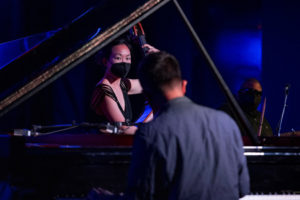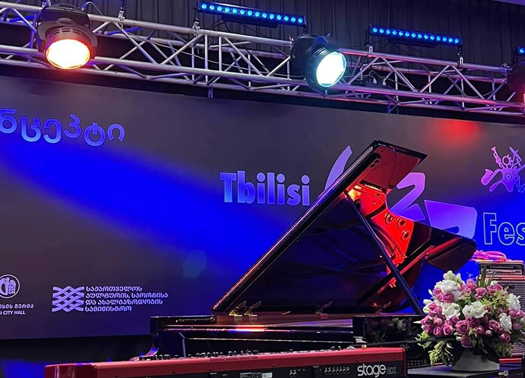Over the past twenty years, the capital of Georgia has firmly established itself on the jazz map of the world as one of the centers and pillars of jazz music. This happened thanks to the annual jazz festivals, which have been held in Tbilisi since 1995.
This is with regard to the autumn forums, and in addition, one should keep in mind the annual summer festivals on the Black Sea coast in Batumi. However, the jazz movement began here in the mid-50s of the last century, then became more active in the late 70s, and in the 80s festivals were held that made a huge impression on jazz lovers, including those outside of Georgia. Especially it should be said about the sensational festival of 1989, which brought together eight ensembles from the USA at once, in each of which the presence of legendary names – stars of the first magnitude – exceeded the highest expectations. How did all this happen?
How Tbilisi became a festival center
Gayoz Kandelaki, a graduate of the motor transport faculty of the State Pedagogical Institute, where he founded the Pirosmani youth club during his student years, was fond of music and basketball. He was only 23 years old when the Tbilisi city authorities offered the enterprising young man to head the municipal improvement department. Soon he set about refurbishing the premises under the Baratashvili bridge to use it as a youth club. This is how the first monastery for creative young people appeared in Tbilisi.
Gathered willingly and showed performances, paintings, arranged concerts of pop, jazz and rock music. Alexander Kiladze created his own orchestra, which then performed together with the Jazz Choral vocal ensemble. There was another ensemble – “Jazz-nonet”, of nine performers. Lovers and performers of jazz music of that time were especially attracted to this club. Such, for example, as double bassist Tamaz Kurashvili, trumpeter Enver Khmyrev, pianists Alexander Rakviashvili, Enri Lolashvili, Eduard Israelov, saxophonists Alexander Manjgaladze and Soso Kasradze, guitarists David Masteranov and Roman Bregvadze, vocalists Irma Sokhadze, Inga Peradze, Guliko Chanturia.
Musicians from other cities and republics were invited for joint performances – more often from Russia, Armenia. Well-known instrumentalists came by that time – trumpeter German Lukyanov, pianists Leonid Chizhik and Mikhail Okun, singers Larisa Dolina and Tatevik Oganesyan. Life in the club, of which Kandelaki was the first president, was seething until he worked there for five years. Then he was appointed director of the city philharmonic, which moved to a new building. And in the very first months of work in a new position, he conceived the idea of holding an all-Union jazz festival and achieved this goal in 1978.
Gaioz managed to convince the party leadership of the aesthetic expediency of such a large-scale event that could bring musicians and audiences from different republics together. And when jazz evenings were held in Tbilisi in 1977, it was, in essence, an international review, which became a kind of rehearsal for a more significant event. These evenings brought together the best performers from Vilnius and Tallinn, Moscow, Kiev, Yerevan, Rostov, and all of them, together with Tbilisi musicians, convinced the director of the Philharmonic Society, a connoisseur and jazz enthusiast, and most importantly, an energetic manager, of the correctness of the decision to hold the first large all-Union forum of jazzmen.

A year later, it took place – Festival-78, which became a demonstration of the capabilities of hundreds of instrumentalists, who were not very famous before, but quite talented. Almost all of the musicians mentioned above, and many others, participated in it. Arriving from different republics, they, together with the stage owners, for the first time in the history of the Soviet Union, had the opportunity to get together and get to know each other better, show their creative level, understand the essence of fresh trends and the difference in style and interpretation of works.
They, curiously, played not only American music – in the sense of compositions known as “standards”, but also their own compositions. You can, for example, name the pieces of the Leningrad multi-instrumentalist David Goloshchekin, the Azerbaijani pianist Vagif Mustafa-zade “Mugham” and “Waiting for Aziza”, the composition of the bass player Tamaz Kurashvili “The Hottest Day in Baku”, “Date” by the Estonian saxophonist Helmut Aniko, the works of the pianist Nikolai Levinovsky, saxophonist Igor Butman and many others.
It is important that then everyone understood one simple thing: regular meetings of musicians allow them to improve their skills and find the right guidelines in their work. And everyone was happy with this chance to make themselves known. The festival received a very good press, including abroad. New names appeared, a more complete idea of the potential of jazz music masters in a country where it was not officially cultivated much arose. Although there were many precedents for the successful performance of certain ensembles, including abroad.

After that, Kandelaki, together with the same group of organizers, began to prepare for the second international festival in Tbilisi, with the participation of musicians from the socialist countries. It took place in 1986. And also with obvious success. But Gaioz hatched a plan even more daring.
Not only musicians arrived at the festival-86, but also, let’s say, active “preachers of jazz” in the person of experts and critics, journalists. With guests from Poland, in particular, with the editor of the music magazine Pavel Brodowski and the director of the international Jazz Jambori festival in Warsaw, Andrzej Biek, he already knew, as well as with Ullis Kannover, a long-term host of jazz broadcasts on the Voice of America radio.







More Stories
CD review: George Benson – Dreams Do Come True: When George Benson Meets Robert Farnon – 2024: Video, CD cover
The band was tight as ever. The Warren Haynes Band cuts loose: Video, Photos
Interview with Alvin Queen: Feeling Good – I heard these tunes played by … Video, new CD cover, Photos